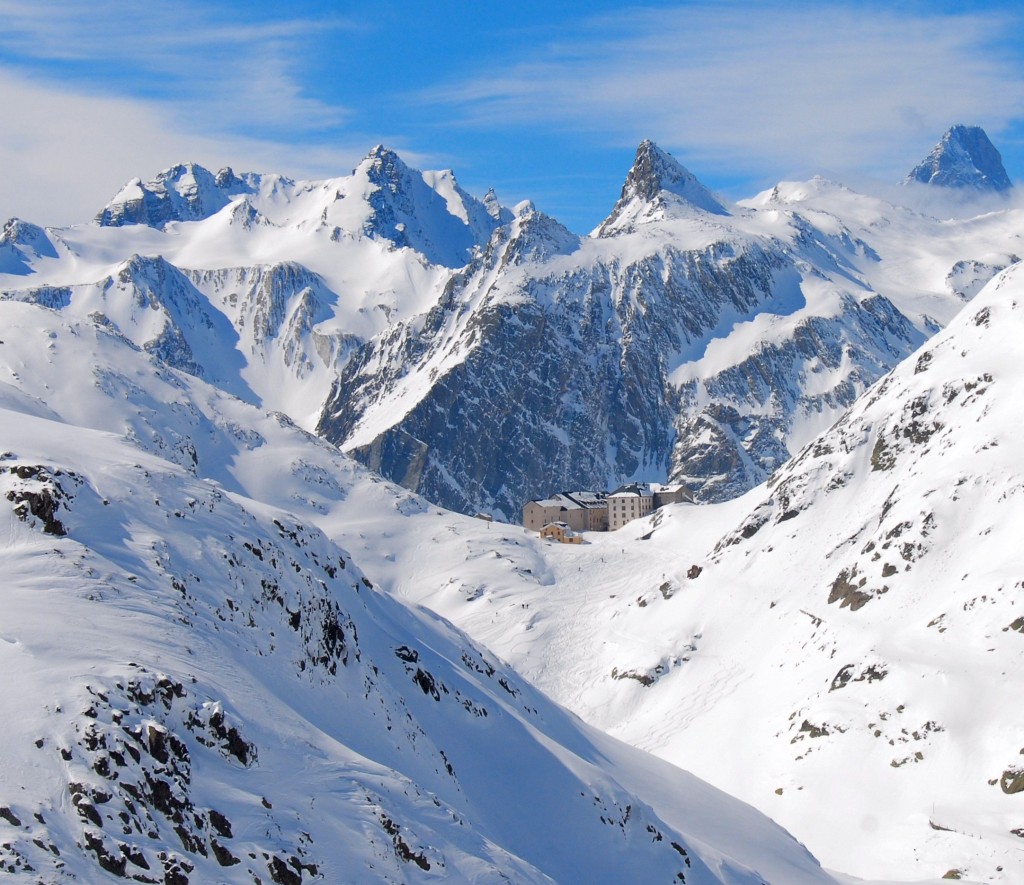
By LiHe Han and Derek DeRoche –
The following article is written by two Stanford undergraduates who, thanks to the generosity of the Institute of Alpine Archaeology, were given the chance to travel to the Great St. Bernard monastery in Valais, Switzerland to study and catalogue medieval seals and documents in the monastery’s archives. They would like to thank Edward Boenig-Liptsin, the Institute (in particular Steve Barrager), Patrick Hunt, and Jean-Pierre Voutaz for their kind assistance.
A clamor of bells echoed through a narrow stone hallway, signaling the evening angelus. The inhabitants of the Great St. Bernard hospice–monks, guests, and employees–filed into the baroque church. Soaring harmonies permeated the old building and floated out into the brisk air of the Swiss Alps. Some moments later, a collective shuffling of feet could be heard, mingled with voices conversing in various languages: French, Italian, German and English blended to form a cheerful din that gradually poured its way into the dining hall.
Dinner was on the table, hearty hostel fare, and we sat down at the long benches. The Italian family next to us asked us to pass the bread basket, and now that the raucous group of Catholic high schoolers (who were on their confirmation retreat) had finally departed, we scrambled to obliged them, and in our turn had to demand the soup tureen from the French woman on our other side. We were later to learn that she was a writer seeking refuge in the isolation of this mountain sanctuary, hoping to finish her book about corporate inspirational strategies. We exchanged friendly nods with the young, red-haired man sitting across from us; having spoken with him at lunch, we knew that he was from Tasmania, and he was currently engaged in a conversation with a middle-aged gentleman from Belfast, on the subject of their mutual endeavor’they were both traveling on foot along the Via Francigena, a pilgrimage route that stretched from Canterbury to Rome. The Great St. Bernard monastery was at the midpoint of this journey, but at 8100 feet it was a long way up and a steep drop down. The Great St. Bernard is covered in snow for most of the year, and is inaccessible by road from September to April. Nevertheless, it is a popular destination run by a flourishing monastic order based in the neighboring town of Martigny, and several monks were always at the hospice, conducting religious services while managing the daily affairs of the hotel. We had the good fortune to be invited to a few meals with the staff; aside from numerous volunteers and employees, there was Chanoine Frédéric the Prior, Chanoine Rafael the jack-of-all-trades, and our official host Chanoine Jean-Pierre Voutaz, the archivist at the Great St. Bernard. At the beginning of the meal, we sat nervously perched on our chairs, unsure of how to behave among such venerable company. However, our inhibitions were quickly done away with. The members of the religious order were more lively and boisterous than any other group in the hospice, and loud shouts of laughter were as abundant at the table as Swiss Valais wine and Swiss Valais cheese. We were taken aback by how casual and welcoming they were, and quickly grew deeply attached to the way in which they applied themselves wholeheartedly to ensure every guest’s pleasure.
Indeed, the Great St. Bernard has been a stronghold of hospitality since the 11th century, when St. Bernard of Menthon founded a mountain lodge that was to tend to travelers and pilgrims, building a shelter in the rocks to protect against the freezing sleet and icy winds. We have crawled into the original grotto, barely large enough to turn around in, and seen the millennium-old candle wax and soot (this grotto was excavated over a decade ago by the Stanford Alpine Archaeology Project). Traversing the mountain pass was a perilous task at the time, and travelers often succumbed to the frigid temperatures and halted their journey forever. Therefore, it was not enough for the monks of the hospice to merely provide food and shelter’they conducted rescue operations as well, and it was to this end that the famous St. Bernard dog breed was created by hybridizing mastiffs for cold weather. The story of the Great St. Bernard makes for a truly cinematic scenario: a group of monks clad in black, skiing down the vertiginous slopes of the Pennine Swiss Alps, as the deep booming barks of their barrel-chested canine companions bounce off the jagged snow-laden peaks.

But the rich history of the Great St. Bernard is not limited to this picturesque vignette. In fact, the hospice is located a few steps away from the site of a former Roman temple to the god Jupiter. But this temple, too, is a reincarnation of a previous structure: for before the Romans arrived in the alps, there had been a Celtic shrine to the mountain god Penn at this very location. Near the hospice, en route to the Italian border, there stands a heavy stone cross that bears witness to the way in which each culture appropriated the ruins of its antecedents: for its base is made of white marmor (a marble-like calc-schist) taken from the Temple of Jupiter, and the stone that was used to construct the pagan Celtic shrine was re-fashioned into the Christian symbol of the cross.
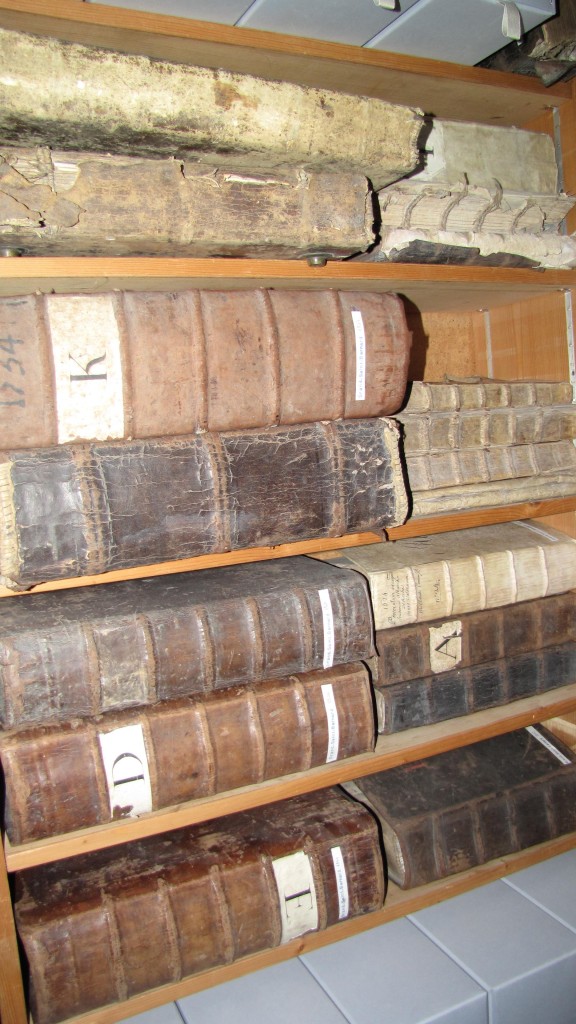
Our specific interest in the Great St. Bernard, however, was not the ground that it was constructed upon, but instead the treasures that lay within the bowels of the stout mountain edifice. The list of marvels we encountered would be interminable, but just to provide a glimpse: there is a magnificent marble façade in the hospice, which brilliant whiteness strikes a stark contrast with the weathered grey stone walls around it. It is the tomb of Louis Desaix, a maréchal (general) of Napoleon’s army, who was killed at the battle of Marengo. Napoleon had, in fact, passed through the monastery with his armée de réserve in 1800, and it was then that he ordered the construction of this monument. In the Trésor (a sort of small museum) found on the first floor of the hospice, there is a plethora of religious relics from centuries past. There is a wooden bust of St. Bernard that dates from the 13th century, which has suffered a significant amount of erosion due to the fact that it was taken along whenever the monks left the monastery on an official visit, as a token of authenticity proving that the monk carrying it was indeed from the Great St. Bernard, and not some fraudulent imposter. The ceremonial sapphire ring worn by St. Bernard himself is there, sparkling with a calm blue light (it is interesting to note that the ring is exceedingly large; this expansive girth has lead people to conjecture that it may have been designed to be worn over thick gloves, or simply that St. Bernard may have been rather heavy-set). The library also contains an extensive collection of historically important volumes, such as the first-edition of the Bible as translated by Erasmus, and several books that were among the first to be printed by the Gutenberg press. The bulk of our time, however, was spent in the archives, to which Chanoine Voutaz kindly granted us access. In addition to this, he also dedicated several days in order to show us artifacts of note: there were gold coins from the time of Alexander the Great, and Roman coins that commemorated the conquest of Judea. We held in our hands Celtic and Roman figurines, and admired a coffee-holder that was tailor made for Napoleon Bonaparte. Despite the risk of head lice, we tentatively tried on a three-cornered hat dating from the French Revolution, and also marveled at the gemstones-encrusted mitre that belonged to an 18th century provost. We were (understandably) starry-eyed over the extraordinary opportunity to have hands-on access to these artifacts, but whenever we gasped with amazement or shook our heads in wonder, Chanoine Voutaz would smile wryly and shrug, saying: “It’s not awful, is it?” He seemed quite bemused by the sight of two American students who could not fathom the notion that the very chairs that they sat on were made before Columbus first laid eyes on the New World.
We had some difficult deciding what subject our research was to center on, but at Mr. Voutaz’s suggestion we focused our project on cataloguing and studying the documents and seals in the archives. The study of seals is known as sigillography, and we applied ourselves to learning the basics of this discipline. But our learning curve was much accelerated by the fact that we had direct access to a huge selection of seals, which were were able to touch with our bare hands. The oldest seals dated back to the 12th Century, but as we encountered more examples, were realized that the tradition extends even to modern times (for example, we found a certificate from 1923 upon which a lacquer seal from the University of Lausanne is affixed). Seals are the direct predecessors of notary stamps, personal signatures, and watermarks. They served the purpose of authenticating a document, of indicating social status and allegiance, and the various materials used and ways in which they were attached to the documents all have symbolic meaning. One way to understand them is as an old, aesthetic manifestation of bureaucratic processes and the societal power structures. They combine the symbolic significance and aesthetic value of heraldry with a practical juridic function.
Although the term “bull” has come to designate any statement issued by the pope, the term actually refers to the specific lead seal that was appended to all papal documents (it is important to note that lead is almost exclusively reserved for the pope’s own seals). A good example of this kind of bull dates from 1156: it resembles a round coin about an inch in diameter, and is attached to a parchment document by a length of yellow silk cord. Like coins, seals that are suspended from documents (as opposed to seals that are attached to the document itself) have images and words inscribed on both sides. In sigillography, the heads side is known as the obverse, and the tails is known as the reverse. Papal bulls have a standard design, whereby the observe side always bears the acronym S.PA.S.PE. (which stands for Sanctus Paulus Sanctus Petrus, Latin for St. Paul and St. Peter) and the heads of St. Paul and St. Peter are depicted; St. Paul can be distinguished by his beard, and St. Peter is known for having curly hair. The current pope’s name is emblazoned on the reverse face of the coin. This particular seal belongs to Pope Adrian IV (born Nicholas Breakspear, occupied the position of pope from 1154-1159 and was the first Englishman to do so), and the document to which it is attached has been sent to the monks of the Great St. Bernard in order to confirm to them that a hospital has been donated to them by the Bishop of Troyes and Henry I, Count of Troyes. As this is good news, the seal is appended to the document with colorful silken strings; on the other hand, if the document in question bore bad news or a reprimand, it is customary to attach the seal with a piece of twine. Thus, the recipients of the document did not even have to read the document to know whether the document announced good news or bad.
Another fascinating papal bull that we discovered in the archives dates back to 1392: it is noteworthy because it was issued under the authority of the first so-called “anti-pope”, Clement VII’he established the Great Schism (which lasted from 1378 to 1417, during which there were two popes: one in Rome and one in Avignon) by establishing a second papal seat, the legitimacy of which was eventually recognized by France, Castile, Portugal and Scotland (England, the Holy Roman Empire, and Flanders remained loyal to the Roman pope). As the authenticity of his papacy was at stake, Clement VII’s personal seal is modeled after the traditional papal bull: the iconography resembles the conventional papal bulls in every except for the fleur-de-lys that embellishes the reverse face of the seal. This emblem is traditionally associated with France and serves, in this case, to indicate the Avignon papacy’s divergence from Rome. It is as though Clement VII is claiming to have upgraded the Roman papacy, by appropriating the original design but imprinting his own personal emblem upon it. Thus, serious political statement has been made through the simple gesture of altering a mere detail.
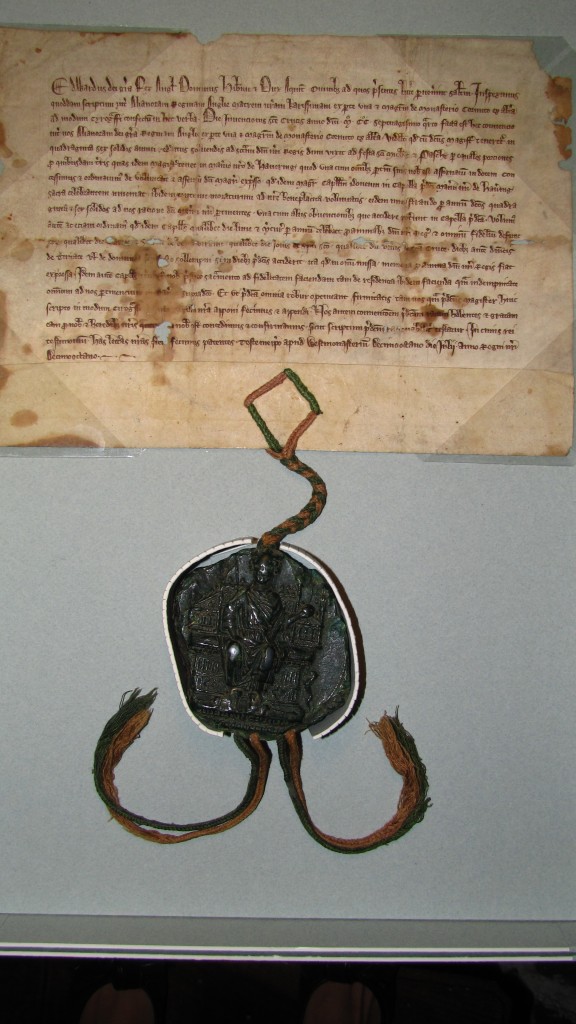
In addition to these ecclesiastic authorities, secular institutions also relied on seals to authenticate documents and display political prowess. One of the most visually impressive seals in the archives is a palm-sized wax seal in a rich green color: this was the royal seal of King Edward I of England, also known as Edward Longshanks (1239-1307). His reign was much preoccupied with a persistent war with Scotland, and this fact is embodied in the iconography of his seal: the reverse face displays Edward in full armor, sitting astride a rearing horse, brandishing a sword in his right hand. Likewise, on the obverse face of the seal, Edward is depicted as a warrior king: he holds a spear under his right arm, and is seated upon a large throne, holding a miniature globe in his left arm. This majestic, warlike pose sent an impressive message to all those who received correspondence from the King: it displayed the extent of his power, and indicated his readiness for battle: those who wished to defy him did so at their own risk.
Another type of secular institution that relied on seals for its routine transactions were notaries and other juridic bodies. We discovered an example of exactly this sort of judiciary seal, which was attached to a document about a 14th century land transaction in the vicinity of the monastery. The seal was a black wax seal, attached to the document by a strip of parchment; it served the function of a notary stamp, indicating the legitimacy of this transaction. This particular seal belonged to Pierre de Billens’judge of the Chablais region in 1307. Further research showed that this seal exactly resembles that of Humbert de Sala, who was his predecessor: thus, one may infer that all those who occupied the position of judge in the Chablais region inherited a standard seal matrix (as opposed to an alternative practice in seal-making that required each new generation to create his own distinctive seal pattern, usually with the aim of preventing forgery; in such cases the old seal matrix was usually destroyed, and sometimes even buried with the body of the deceased predecessor). The iconography consists of a shield, bearing upon it the shape of a cross with arms of equal length. This, in itself, is not an exceedingly remarkable design: square crosses can be found in many contexts, and does not immediately lend itself to any specific interpretation. However, we were convinced that the emblem was familiar to us from some other seals that we had recently worked with: eventually, we realized that the square cross was a prominent feature in the coat-of-arms of the House of Savoy (which was founded in the 11th century, in modern-day Switzerland; they gradually accumulated a considerable amount of power in Europe, and became the royal family of unified Italy from 1861 until the end of WWII). The archives actually housed a great deal of documents that were issued by various members of the House of Savoy, as it had always played a heavy-handed role in the development and growth of the St. Bernard community. The region of Chablais is situated within territory that historically belonged the Savoy family, so it was only natural that the judge of Chablais would show allegiance by employing a characteristic Savoy symbol in their own seals.
The archive contains a document that testifies to the relationship between the Great St. Bernard and the House of Savoy; the document was issued in August of 1466, by Amédée of Savoy, and is intended as a sort of statement of protection for the Great St. Bernard monastery.The document also exempts the monks from all tolls and salt taxes’a privilege that is hardly surprising when one learns that his brother, François of Savoy, was actually the provost of the Great St. Bernard monastery at this time. The seal attached to this act of safe-conduct is a heraldic seal, which bears his coat-of-arms (the square cross that characterizes the Savoy house is prominently featured in the middle of the seal). It is worth noting that the wax seal is enclosed in a round wooden container: it was probably designed to protect the seal from damage, or simply a decorative element which demonstrated the Savoy family’s wealth and nobility.
It is important to observe that it is also common to find several seals attached to the same document: the number of seals, in addition to specifying the issuing authority, also represents the number of parties participating in the agreement, or the number of witnesses present. On one particular occasion, we found a document that actually had eight separate seals attached to it. The nature of the document is also noteworthy, as it describes a religious practice that seems quaint and absurd to modern eyes: the granting of indulgences. In this case, eight different cardinals (whose seals are individually attached) decreed that any pious Christians who visited the Church at Colonne-Joux (also known as the Petit St. Bernard, many miles away to the southwest) would be granted an indulgence of one hundred days, to be deducted from the total of the penances expected of them. The eight seals are all in the shape known as a vesica (which resembles a football): this was common for ecclesiastic seals. As is standard practice for religious authorities, the seals all depict saints, among which the most popular at St. Peter, St. Paul, and the Virgin Mary.
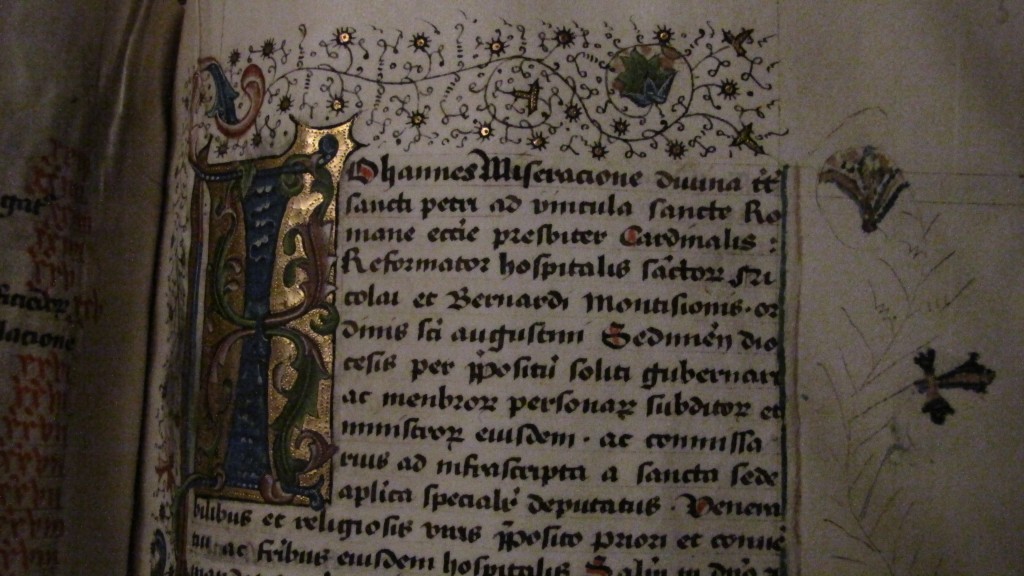
One of the most extraordinary items that we had the privilege to study was the volume from 1438 known as the “Codex Magnifique.” A codex is an early form of book, made by binding parchment sheets together. They were extremely expensive; a single book could cost more than a set of furniture due to the fact that an entire sheep had to be sacrificed for a single sheet of parchment. This particular codex contained the Constitution of Pope Benedict XII, the Law of St. Augustine, and the Constitution of the Order of St. Nicholas and St. Bernard. These were key texts that laid down the fundaments of the monastic commitment that every monk was expected to live up to. The volume is also an especially impressive physical specimen, as it is bound in sheepskin and studded on both sides with large brass caps. It was worn as a ceremonial ornament by religious officials, as a symbolic gesture which showed that they carried the law with them (part of the leather binding of the book extended to form a tail, which would be tied to a priest’s waist).
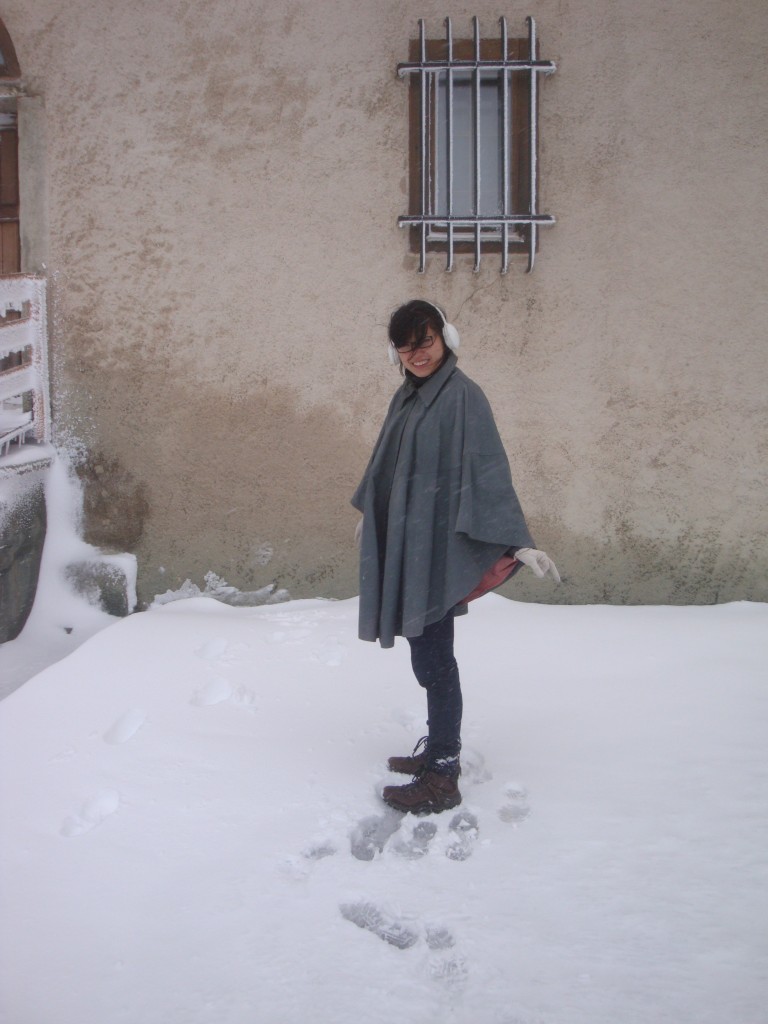

These are only a few examples of the vast collection of treasures at the monastery. Having the chance to look through and study these items was a new kind of history lesson for us, showing us not the major battles or world-changing events, but the details and routine procedures that lay behind the well-known power structures. These artifacts were not necessarily useful as evidence of some larger theory or discovery, but were rather aesthetically interesting and valuable in themselves, as a witness to the genealogy of human practices through the ages. They were a window into the more personal, day-to-day business of people and institutions. It was somewhat surprising to encounter such complex bureaucratic systems in what we often think of as much simpler times. We enjoyed beholding the beautiful artistry that went into the seal-making and writing, while also thinking critically about the purposes of displaying strength and control that lay behind the craftsmanship. We may not have made a groundbreaking and lasting contribution to the historical record, but thanks to our efforts and the tremendous support of others, we were fortunate enough to have a personal look at a piece of history, something we encourage others to pursue. For history is of personal, and not merely social, importance.